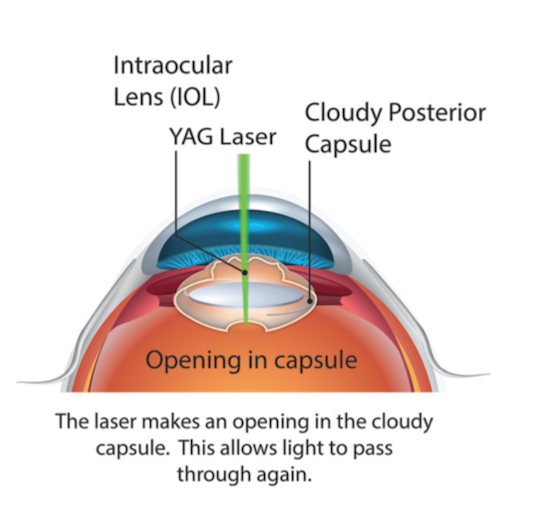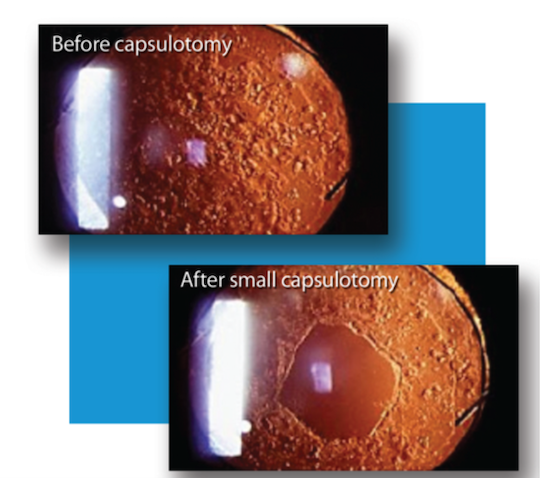YAG Capsulotomy
Posterior Capsular Opacification (PCO) Basics
The human lens sits in a bag or capsule. Ideally, when cataract surgery occurs, we want to maintain that bag/capsule intact. If we succeed in doing that, the back of that bag/capsule can become cloudy over time and sometimes we simply cannot clean the back of the bag/capsule safely during surgery. It can happen commonly, up to 50% of the time after cataract surgery depending on the patient and situation. We call this a Posterior Capsular Opacification (PCO). Thankfully, we can fix this relatively quickly and easily in the office with a laser procedure called YAG capsulotomy.
 What is YAG Capsulotomy Laser?
What is YAG Capsulotomy Laser?
It is a laser applied to the posterior aspect of the bag/capsule where your intraocular lens is sitting. If you’ve been recommended this procedure, chances are that the posterior aspect of that bag/capsule has become cloudy/opacified. We call this a posterior capsular opacification (PCO). The laser makes a hole in the center of that PCO so that you can see better. There is a small risk of retinal detachment and retinal swelling after this laser, but these risks are very rare (usually less than 1 in 1000). Rarely the procedure needs to be repeated. The large majority of patients undergoing this laser experience improved vision within weeks.
Who is a Great Candidate?
YAG capsulotomy works best when a PCO is identified. PCOs can cause a decline in vision after cataract surgery or can explain why some patients may have never experienced the best possible vision after cataract surgery. Your eye doctor will help you decide if YAG capsulotomy can help. Since the risk is minimal, if you’re experiencing vision difficulties after cataract surgery, and we think a PCO may be contributing, we recommend proceeding with the laser.
Can a YAG Laser treatment help your PCO symptoms?
How is it Done?
Typically we'll ask you to come to the office 60 to 90 minutes before the procedure, so that we can prep the eye for the laser. One of our skilled staff members will corroborate the eye being lasered (and mark the eye), make sure there is a consent form in place, and place eye drops in the eye. The eye drops will dilate the pupil. This step is crucial as it allows the eye surgeon to clearly see the PCO.
When the eye surgeon walks in to do the laser, we'll perform a safety check one more time, place numbing drops in both eyes to minimize blinking, and place a lens with gel on the eye. YAG capsulotomy takes 5-10 minutes.
After the laser, one of our staff members will clean your eye and place some extra drops in it. You can then go home and use dark glasses to protect your dilated eye from sunlight.

What is the Follow-Up?
You'll typically return in 2-4 weeks to check your vision. At that point, if the other eye needs the laser, we can book the procedure for the other eye, if appropriate. Once both eyes are done, one of our eye doctors can then safely measure you for glasses, if needed, and if no other problems are found with the eye.
There are no restrictions associated with the laser. You can typically return to work immediately, if you desire. Vision in the lasered eye may be a bit blurry and you may experience some floaters for 1 to 3 days. Preservative-free tears may help with the blurring.
Sometimes and depending on the circumstances, your eye doctor may ask you to use anti-inflammatory eye drops after the laser.

Benefits
- It's extremely safe
- It may improve vision permanently
- It's a quick office procedure
Reminder
As with any procedure, there are never guarantees. You may still need glasses or a change in glasses after this procedure. You may also still need to be treated for any other eye problems to help retain or improve vision.
Schedule an appointment at one of our convenient locations.

